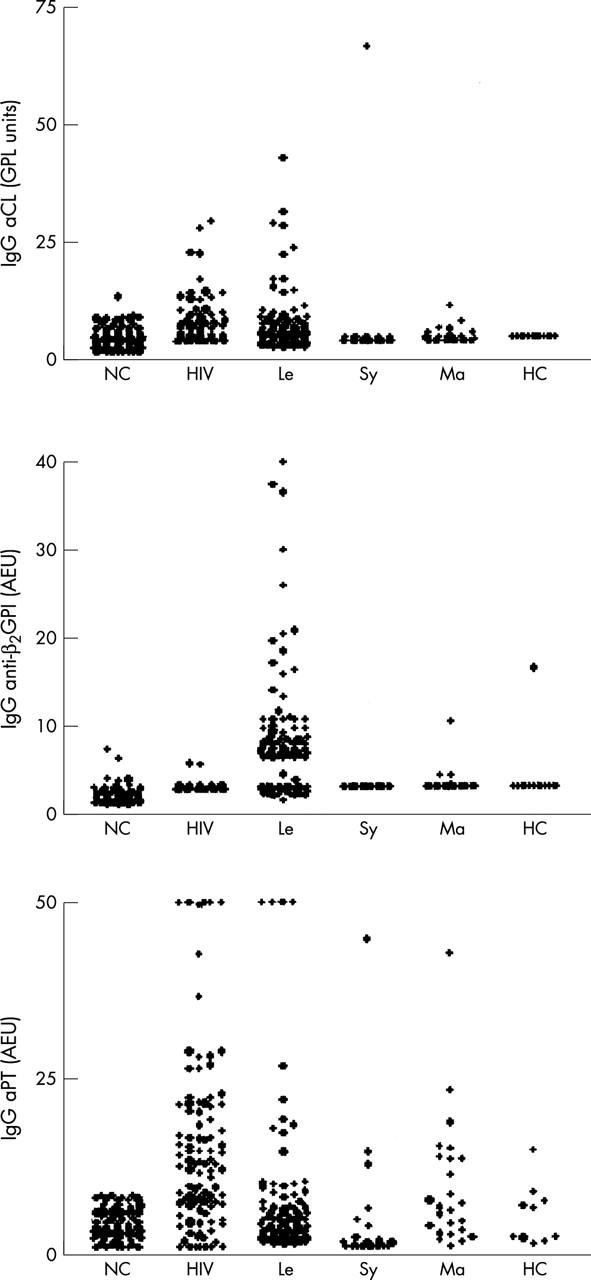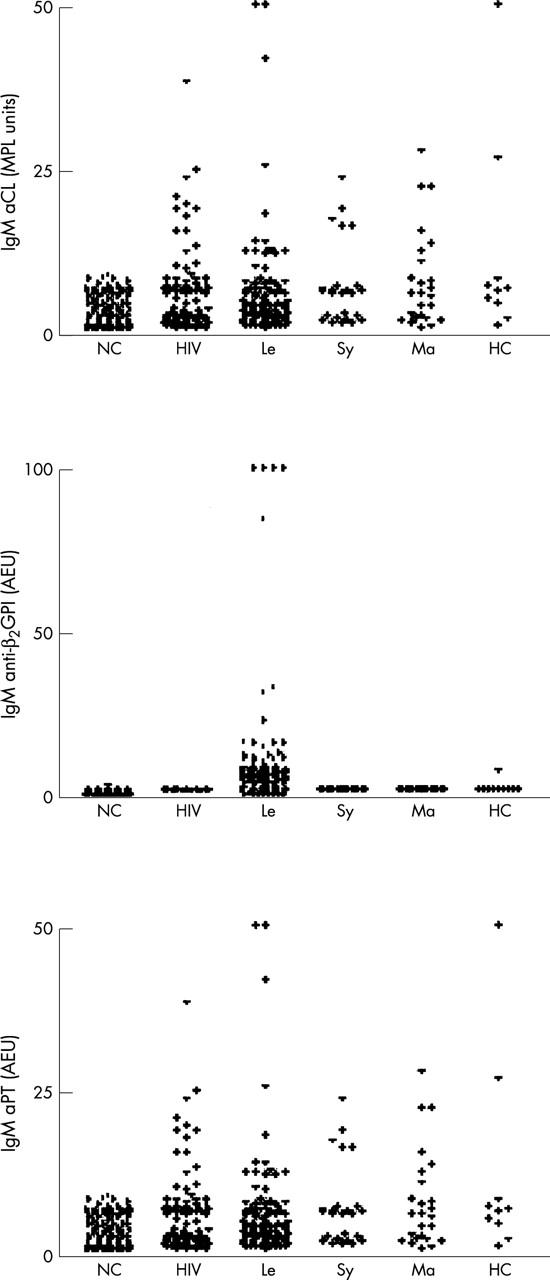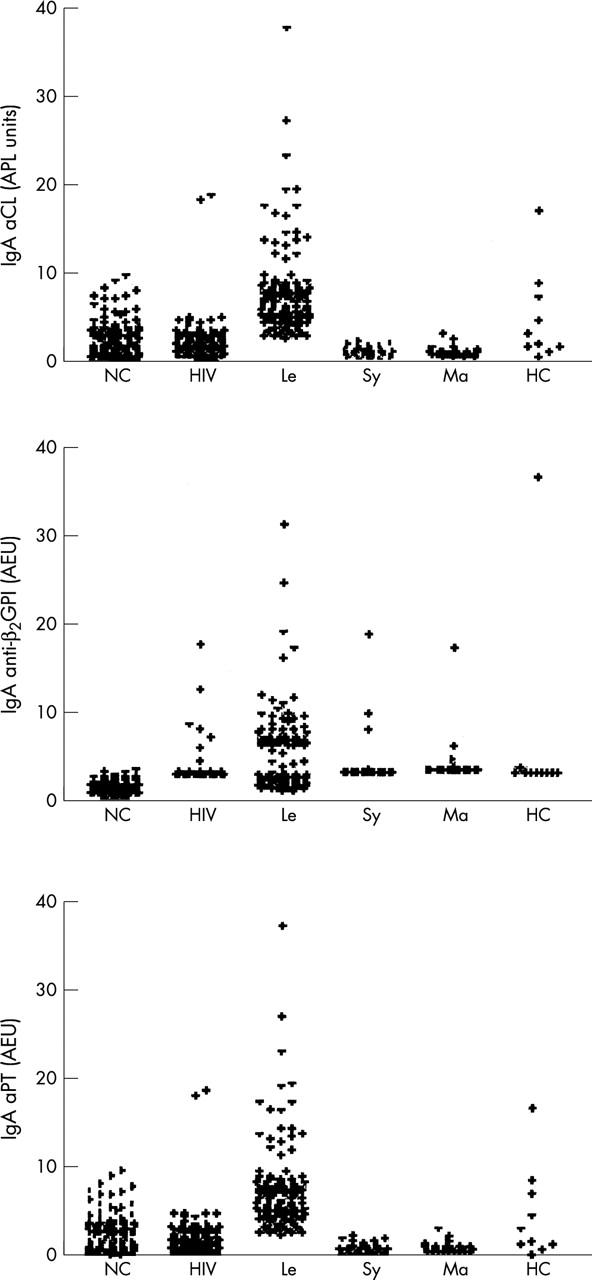Abstract
Objectives: To investigate IgG, IgM, and IgA, antiphospholipid antibodies (aPL), against cardiolipin (aCL), ß2-glycoprotein I (anti-ß2GPI), and prothrombin (anti-PT), in black South African patients with infectious disease. Unlike patients with systemic lupus erythematosus (SLE) and the antiphospholipid syndrome (APS), raised levels of aPL in infectious diseases are not usually associated with thrombotic complications.
Patients and methods: Serum samples from 272 patients with a variety of infectious diseases (100 HIV positive, 112 leprosy, 25 syphilis, 25 malaria, and 10 HCV patients) were studied and compared with autoantibody levels in 100 normal controls. All three aPL were measured using commercial enzyme linked immunosorbent assay (ELISA) kits.
Results: Raised levels of all thee aPL were found in all patient groups studied: aCL in 7%, anti-ß2GPI in 6%, and aPT in 43% of 100 HIV patients, in 29%, 89%, and 21% of 112 patients with leprosy, in 8%, 8%, and 28% of 25 patients with syphilis, in 12%, 8%, and 28% of 25 patients with malaria, and in 20%, 30%, and 30% of 10 HCV patients studied, respectively.
Conclusions: The prevalence of aCL and anti-ß2GPI in black South African HIV positive patients, or those with syphilis, malaria, or hepatitis C virus is lower than reported for mixed race or white populations. aPT were the most prevalent aPL detected in these patient groups, except in patients with leprosy, for whom anti-ß2GPI was the most prevalent, and where the spectrum of aPL was similar to that seen in patients with SLE and APS.
Full Text
The Full Text of this article is available as a PDF (348.3 KB).
Figure 1 .

IgG aCL, anti-ß2GPI and aPT antibody levels in normal controls (NC) and in patients with HIV, leprosy (Le), syphilis (Sy), malaria (Ma), hepatitis C (HC). The upper limit of normal, set at 5SD above the mean level of the normal controls, was 16 GPL for aCL, 6.7 AEU for anti-ß2GPI, and 13.8 AEU for aPT.
Figure 2 .

IgM aCL, anti-ß2GPI, and aPT antibody levels in normal controls (NC), and in patients with HIV, leprosy (Le), syphilis (Sy), malaria (Ma), hepatitis C (HC). The upper limit of normal set at 5SD above the mean level of the normal controls, was 9.6 MPL for aCL, 4.5 AEU for anti-ß2GPI, and 16 AEU for aPT.
Figure 3 .

IgA aCL, anti-ß2GPI, and aPT antibody levels in normal controls (NC), and in patients with HIV, leprosy (Le), syphilis (Sy), malaria (Ma), hepatitis C (HC). The upper limit of normal set at 5SD above the mean level of the normal controls, was 8.7 APL for aCL, 4.6 AEU for anti-ß2GPI, and 13.5 AEU for aPT.
Selected References
These references are in PubMed. This may not be the complete list of references from this article.
- Abuaf N., Laperche S., Rajoely B., Carsique R., Deschamps A., Rouquette A. M., Barthet C., Khaled Z., Marbot C., Saab N. Autoantibodies to phospholipids and to the coagulation proteins in AIDS. Thromb Haemost. 1997 May;77(5):856–861. [PubMed] [Google Scholar]
- Arvieux J., Darnige L., Caron C., Reber G., Bensa J. C., Colomb M. G. Development of an ELISA for autoantibodies to prothrombin showing their prevalence in patients with lupus anticoagulants. Thromb Haemost. 1995 Oct;74(4):1120–1125. [PubMed] [Google Scholar]
- Asherson R. A., Cervera R., Piette J. C., Shoenfeld Y., Espinosa G., Petri M. A., Lim E., Lau T. C., Gurjal A., Jedryka-Góral A. Catastrophic antiphospholipid syndrome: clues to the pathogenesis from a series of 80 patients. Medicine (Baltimore) 2001 Nov;80(6):355–377. doi: 10.1097/00005792-200111000-00002. [DOI] [PubMed] [Google Scholar]
- Asherson R. A., Shoenfeld Y. The role of infection in the pathogenesis of catastrophic antiphospholipid syndrome--molecular mimicry? J Rheumatol. 2000 Jan;27(1):12–14. [PubMed] [Google Scholar]
- Asherson R. A. The catastrophic antiphospholipid syndrome. J Rheumatol. 1992 Apr;19(4):508–512. [PubMed] [Google Scholar]
- Blank Miri, Krause Ilan, Fridkin Mati, Keller Nathan, Kopolovic Juri, Goldberg Iris, Tobar Ana, Shoenfeld Yehuda. Bacterial induction of autoantibodies to beta2-glycoprotein-I accounts for the infectious etiology of antiphospholipid syndrome. J Clin Invest. 2002 Mar;109(6):797–804. doi: 10.1172/JCI12337. [DOI] [PMC free article] [PubMed] [Google Scholar]
- Carreras L. O., Forastiero R. R., Martinuzzo M. E. Which are the best biological markers of the antiphospholipid syndrome? J Autoimmun. 2000 Sep;15(2):163–172. doi: 10.1006/jaut.2000.0401. [DOI] [PubMed] [Google Scholar]
- Elbeialy A., Strassburger-Lorna K., Atsumi T., Bertolaccini M. L., Amengual O., Hanafi M., Khamashta M. A., Hughes G. R. Antiphospholipid antibodies in leprotic patients: a correlation with disease manifestations. Clin Exp Rheumatol. 2000 Jul-Aug;18(4):492–494. [PubMed] [Google Scholar]
- Facer C. A., Agiostratidou G. High levels of anti-phospholipid antibodies in uncomplicated and severe Plasmodium falciparum and in P. vivax malaria. Clin Exp Immunol. 1994 Feb;95(2):304–309. doi: 10.1111/j.1365-2249.1994.tb06528.x. [DOI] [PMC free article] [PubMed] [Google Scholar]
- Fiallo P., Travaglino C., Nunzi E., Cardo P. P. beta 2-Glycoprotein I-dependence of anticardiolipin antibodies in multibacillary leprosy patients. Lepr Rev. 1998 Dec;69(4):376–381. doi: 10.5935/0305-7518.19980038. [DOI] [PubMed] [Google Scholar]
- Forastiero R. R., Martinuzzo M. E., Kordich L. C., Carreras L. O. Reactivity to beta 2 glycoprotein I clearly differentiates anticardiolipin antibodies from antiphospholipid syndrome and syphilis. Thromb Haemost. 1996 May;75(5):717–720. [PubMed] [Google Scholar]
- Galli M., Dlott J., Norbis F., Ruggeri L., Cler L., Triplett D. A., Barbui T. Lupus anticoagulants and thrombosis: clinical association of different coagulation and immunologic tests. Thromb Haemost. 2000 Dec;84(6):1012–1016. [PubMed] [Google Scholar]
- Galli M., Finazzi G., Bevers E. M., Barbui T. Kaolin clotting time and dilute Russell's viper venom time distinguish between prothrombin-dependent and beta 2-glycoprotein I-dependent antiphospholipid antibodies. Blood. 1995 Jul 15;86(2):617–623. [PubMed] [Google Scholar]
- Gharavi A. E., Pierangeli S. S., Harris E. N. Origin of antiphospholipid antibodies. Rheum Dis Clin North Am. 2001 Aug;27(3):551–563. doi: 10.1016/s0889-857x(05)70219-2. [DOI] [PubMed] [Google Scholar]
- González C., Lestón A., García-Berrocal B., Sánchez-Rodriguez A., Martín-Oterino J. A., Alberca I., Cordero M., Jorge R., Navajo J. A., González-Buitrago J. M. Antiphosphatidylserine antibodies in patients with autoimmune diseases and HIV-infected patients: effects of Tween 20 and relationship with antibodies to beta2-glycoprotein I. J Clin Lab Anal. 1999;13(2):59–64. doi: 10.1002/(SICI)1098-2825(1999)13:2<59::AID-JCLA3>3.0.CO;2-Q. [DOI] [PMC free article] [PubMed] [Google Scholar]
- Guedes Barbosa L. S., Gilbrut B., Shoenfeld Y., Scheinberg M. A. Autoantibodies in leprosy sera. Clin Rheumatol. 1996 Jan;15(1):26–28. doi: 10.1007/BF02231680. [DOI] [PubMed] [Google Scholar]
- Guerin J., Feighery C., Sim R. B., Jackson J. Antibodies to beta2-glycoprotein I--a specific marker for the antiphospholipid syndrome. Clin Exp Immunol. 1997 Aug;109(2):304–309. doi: 10.1046/j.1365-2249.1997.4601357.x. [DOI] [PMC free article] [PubMed] [Google Scholar]
- Guglielmone H., Vitozzi S., Elbarcha O., Fernandez E. Cofactor dependence and isotype distribution of anticardiolipin antibodies in viral infections. Ann Rheum Dis. 2001 May;60(5):500–504. doi: 10.1136/ard.60.5.500. [DOI] [PMC free article] [PubMed] [Google Scholar]
- Guérin V., Ryman A., Couchouron A. Transitory anti-beta2-glycoprotein I antibodies in infections. Lupus. 1999;8(6):490–491. doi: 10.1177/096120339900800618. [DOI] [PubMed] [Google Scholar]
- Harada M., Fujisawa Y., Sakisaka S., Kawaguchi T., Taniguchi E., Sakamoto M., Sumie S., Sasatomi K., Koga H., Torimura T. High prevalence of anticardiolipin antibodies in hepatitis C virus infection: lack of effects on thrombocytopenia and thrombotic complications. J Gastroenterol. 2000;35(4):272–277. doi: 10.1007/s005350050345. [DOI] [PubMed] [Google Scholar]
- Hojnik M., Gilburd B., Ziporen L., Blank M., Tomer Y., Scheinberg M. A., Tincani A., Rozman B., Shoenfeld Y. Anticardiolipin antibodies in infections are heterogenous in their dependency on beta 2-glycoprotein I: analysis of anticardiolipin antibodies in leprosy. Lupus. 1994 Dec;3(6):515–521. doi: 10.1177/096120339400300615. [DOI] [PubMed] [Google Scholar]
- Hu D. J., Dondero T. J., Rayfield M. A., George J. R., Schochetman G., Jaffe H. W., Luo C. C., Kalish M. L., Weniger B. G., Pau C. P. The emerging genetic diversity of HIV. The importance of global surveillance for diagnostics, research, and prevention. JAMA. 1996 Jan 17;275(3):210–216. [PubMed] [Google Scholar]
- Leroy V., Arvieux J., Jacob M. C., Maynard-Muet M., Baud M., Zarski J. P. Prevalence and significance of anticardiolipin, anti-beta2 glycoprotein I and anti-prothrombin antibodies in chronic hepatitis C. Br J Haematol. 1998 Jun;101(3):468–474. doi: 10.1046/j.1365-2141.1998.00722.x. [DOI] [PubMed] [Google Scholar]
- Petrovas C., Vlachoyiannopoulos P. G., Kordossis T., Moutsopoulos H. M. Anti-phospholipid antibodies in HIV infection and SLE with or without anti-phospholipid syndrome: comparisons of phospholipid specificity, avidity and reactivity with beta2-GPI. J Autoimmun. 1999 Nov;13(3):347–355. doi: 10.1006/jaut.1999.0324. [DOI] [PubMed] [Google Scholar]
- Puurunen M., Vaarala O., Julkunen H., Aho K., Palosuo T. Antibodies to phospholipid-binding plasma proteins and occurrence of thrombosis in patients with systemic lupus erythematosus. Clin Immunol Immunopathol. 1996 Jul;80(1):16–22. doi: 10.1006/clin.1996.0089. [DOI] [PubMed] [Google Scholar]
- Roubey R. A. Immunology of the antiphospholipid antibody syndrome. Arthritis Rheum. 1996 Sep;39(9):1444–1454. doi: 10.1002/art.1780390903. [DOI] [PubMed] [Google Scholar]
- Salcido-Ochoa Francisco, Cabiedes Javier, Alarcón-Segovia Donato, Cabral Antonio R. Antiprothrombin antibodies in patients with systemic lupus erythematosus or with primary antiphospholipid syndrome. J Clin Rheumatol. 2002 Oct;8(5):251–255. doi: 10.1097/00124743-200210000-00004. [DOI] [PubMed] [Google Scholar]
- Santiago M. B., Stellin R., Gaburo Júnior N., Bueno C., Viana V. S., Cossermelli W., de-Oliveira R. M. Antiphospholipid antibodies in syphilis. Braz J Med Biol Res. 1990;23(5):397–402. [PubMed] [Google Scholar]
- Soni P. N., De Bruyn C. C., Duursma J., Sharp B. L., Pudifin D. J. Are anticardiolipin antibodies responsible for some of the complications of severe acute Plasmodium falciparum malaria? S Afr Med J. 1993 Sep;83(9):660–662. [PubMed] [Google Scholar]
- de Larrañaga G. F., Forastiero R. R., Carreras L. O., Alonso B. S. Different types of antiphospholipid antibodies in AIDS: a comparison with syphilis and the antiphospholipid syndrome. Thromb Res. 1999 Oct 1;96(1):19–25. doi: 10.1016/s0049-3848(99)00059-6. [DOI] [PubMed] [Google Scholar]
- de Larrañaga G. F., Forastiero R. R., Martinuzzo M. E., Carreras L. O., Tsariktsian G., Sturno M. M., Alonso B. S. High prevalence of antiphospholipid antibodies in leprosy: evaluation of antigen reactivity. Lupus. 2000;9(8):594–600. doi: 10.1191/096120300678828712. [DOI] [PubMed] [Google Scholar]


